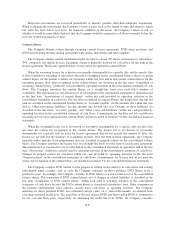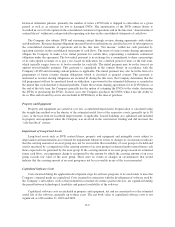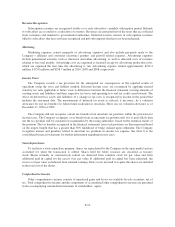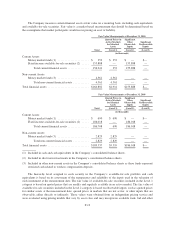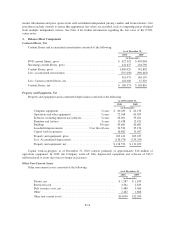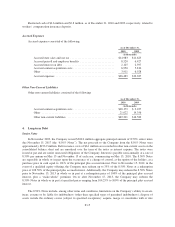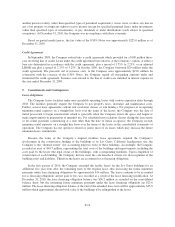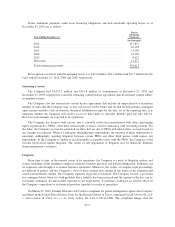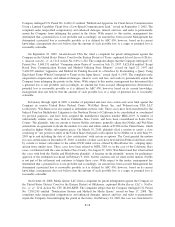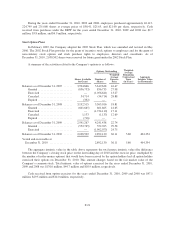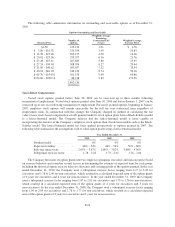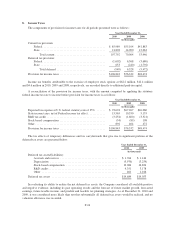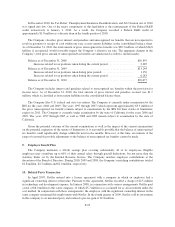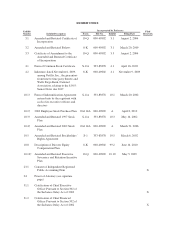NetFlix 2010 Annual Report Download - page 62
Download and view the complete annual report
Please find page 62 of the 2010 NetFlix annual report below. You can navigate through the pages in the report by either clicking on the pages listed below, or by using the keyword search tool below to find specific information within the annual report.Company infringed U.S. Patent No. 6,446,111 entitled “Method and Apparatus for Client-Server Communication
Using a Limited Capability Client Over a Low-Speed Communication Link,” issued on September 3, 2002. The
complaint seeks unspecified compensatory and enhanced damages, interest and fees, and seeks to permanently
enjoin the Company from infringing the patent in the future. With respect to this matter, management has
determined that a potential loss is not probable and accordingly, no amount has been accrued. Management has
determined a potential loss is reasonably possible as it is defined by ASC 450; however, based on its current
knowledge, management does not believe that the amount of such possible loss or a range of potential loss is
reasonably estimable.
On September 25, 2009, Alcatel-Lucent USA Inc. filed a complaint for patent infringement against the
Company in the United States District Court for the Eastern District of Texas, captioned Alcatel-Lucent USA Inc.
v. Amazon.com Inc., et. al, Civil Action No. 6:09-cv-422. The complaint alleges that the Company infringed U.S.
Patents Nos. 5,649,131 entitled “Communications Protocol” issued on July 15, 1997, 5,623,656 entitled “Script
Based Data Communication System and Method Utilizing State Memory” issued on April 22, 1997 and
5,404,507 entitled “Apparatus and Method for Finding Records in a Database by Formulating a Query Using
Equivalent Terms Which Correspond to Terms in the Input Query,” issued April 4, 1995. The complaint seeks
unspecified compensatory and enhanced damages, interest, costs and fees, and seeks to permanently enjoin the
Company from infringing the patents in the future. With respect to this matter, management has determined that
a potential loss is not probable and accordingly, no amount has been accrued. Management has determined a
potential loss is reasonably possible as it is defined by ASC 450; however, based on its current knowledge,
management does not believe that the amount of such possible loss or a range of potential loss is reasonably
estimable.
In January through April of 2009, a number of purported anti-trust class action suits were filed against the
Company in various United States Federal Courts. Wal-Mart Stores, Inc. and Walmart.com USA LLC
(collectively, Wal-Mart) were also named as defendants in these suits. These cases have been transferred by the
Judicial Panel on Multidistrict Litigation to the Northern District of California to be consolidated or coordinated
for pre-trial purposes, and have been assigned the multidistrict litigation number MDL-2029. A number of
substantially similar suits were filed in California State Courts, and have been consolidated in Santa Clara
County. The plaintiffs, who are current or former Netflix customers, generally allege that Netflix and Wal-Mart
entered into an agreement to divide the markets for sales and online rentals of DVDs in the United States, which
resulted in higher Netflix subscription prices. On March 19, 2010, plaintiffs filed a motion to certify a class
consisting of “any person or entity in the United States that paid a subscription fee to Netflix on or after May 19,
2005 up to and including the date of class certification” with certain exceptions. The Court granted the motion
for class certification on December 23, 2010. A number of other cases have been filed in Federal and State courts
by current or former subscribers to the online DVD rental service offered by Blockbuster Inc., alleging injury
arising from similar facts. These cases have been related to MDL 2029 or, in the case of the California State
cases, coordinated with the cases in Santa Clara County. On August 27, 2010, Wal-Mart stated that it had settled
the cases with both the Netflix and Blockbuster plaintiffs. A hearing on the plaintiffs’ motion for preliminary
approval of the settlement was heard on February 9, 2011, but the court has not yet ruled on the motion. Netflix
is not part of the settlement and continues to litigate these cases. With respect to this matter, management has
determined that a potential loss is not probable and accordingly, no amount has been accrued. Management has
determined a potential loss is reasonably possible as it is defined by ASC 450; however, based on its current
knowledge, management does not believe that the amount of such possible loss or a range of potential loss is
reasonably estimable.
On October 24, 2008, Media Queue, LLC filed a complaint for patent infringement against the Company in
the United States District Court for the Eastern District of Oklahoma, captioned Media Queue, LLC v. Netflix,
Inc., et. al , Civil Action No. CIV 08-402-KEW. The complaint alleges that the Company infringed U.S. Patent
No. 7,389,243 entitled “Notification System and Method for Media Queue” issued on June 17, 2008. The
complaint seeks unspecified compensatory and enhanced damages, interest and fees, and seeks to permanently
enjoin the Company from infringing the patent in the future. On February 24, 2009, the case was transferred to
F-18


